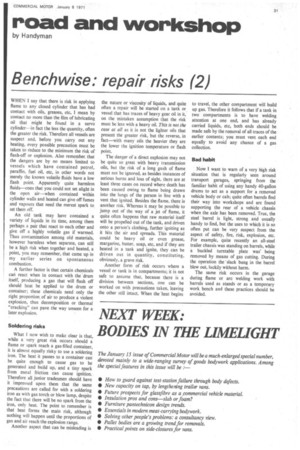Benchwise: repair risks (2)
Page 33

If you've noticed an error in this article please click here to report it so we can fix it.
WHEN I say that there is risk in applying flame to any closed cylinder that has had contact with oils, greases, etc, I mean by contact no more than the film of lubricating oil that might be found in a servo cylinder—in fact the less the quantity, often the greater the risk. Therefore all vessels are suspect and, before you carry out any heating, every possible precaution must be taken to reduce to the minimum the risk of flash-off or explosion. Also remember, that the dangers are by no means limited to vessels which have contained petrol, paraffin, fuel oil, etc, in other words not merely the known volatile fluids have a low flash point Apparently quite harmless fluids—ones that you could not set alight in the open air—when contained within cylinder walls and heated can give off fumes and vapours that need the merest spark to set them off.
An old tank may have contained a variety of liquids in its time, among them perhaps a pair that react to each other and give off a highly volatile gas if warmed. Thus contamination among old materials, however harmless when separate, can still be a high risk when together and heated, a point, you may remember, that came up in my earlier series on spontaneous combustion.
A further factor is that certain chemicals can react when in contact with the 'drum itself, producing a gas that will flash off should heat be applied to the drum or container; these chemicals need only the right proportion, of air to produce a violent explosion, thus decomposition or thermal "cracking" can pave the way unseen for a later explosion. the nature or viscosity of liquids, and quite often a repair will be started on a tank or, vessel that has traces of heavy gear oil in it, on the mistaken assumption that the risk must be less with a heavy oil. This is not the case at all as it is not the lighter oils that present the greater risk, but the reverse, in fact—with many oils the heavier they are the lower the ignition temperature or flash point.
The danger of a direct explosion may not be quite so great with heavy transmission oils, but the risk of a long gush of flame must not be ignored, as besides instances of serious burns and loss of sight, there are at least three cases on record where death has been caused owing to flame being drawn into the lungs of the person in line with a vent that ignited. Besides the flame, there is another risk. Whereas it may be possible to jump out of the way of a jet of flame, it quite often happens that raw material itself will be propelled out of the tank, and driven onto a person's clothing, further igniting as it hits the air and spreads. This material could be heavy oil or even grease, margarine, butter, soap, etc, and if they are heated in a tank and ignite, they can be driven out in quantity, constituting, obviously, a grave risk.
Another form of risk occurs where a vessel or tank is in compartments; it is not safe to assume that, because there is a division between sections, one can be worked on with precautions taken, leaving the other still intact. When the 'heat begins
to travel, the other compartment will build up gas. Therefore it follows that if a tank in two compartments is to have welding attention at one end, and has already carried liquids, etc, both ends should be made safe by the removal of all traces of the earlier contents; you must vent each end equally to avoid any chance of a gas collection.
Bad habit
Now I want to warn of a very high risk situation that is regularly seen around transport garages, springing from the familiar habit of using any handy 40-gallon drums to act as a support for a removed vehicle body or cab; quite often barrels find their way into workshops and are found supporting the rear of a vehicle chassis when the axle has been removed. True, the steer barrel is light, strong and usually handy to find, but the uses to which it is so often put can be very suspect from the aspect of safety, fire, risk, explosion, etc. For example, quite recently an all-steel trailer chassis was standing on barrels, while a buckled turntable plate was' being removed by means of gas cutting. During the operation the 'slack bung in the barrel blew out, luckily without harm.
The same risk occurs in the garage during flame or arc welding work with barrels used as stands or as a temporary work bench and these practices should be avoided.












































































































































